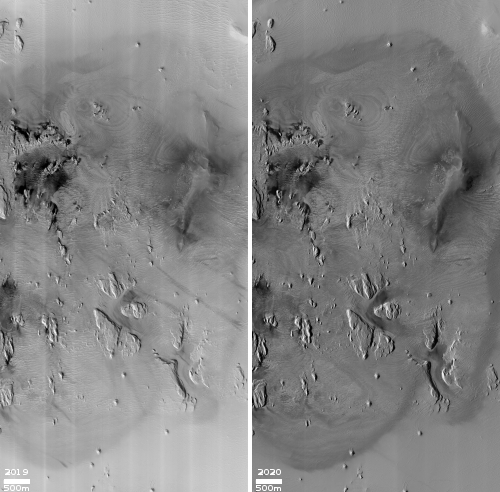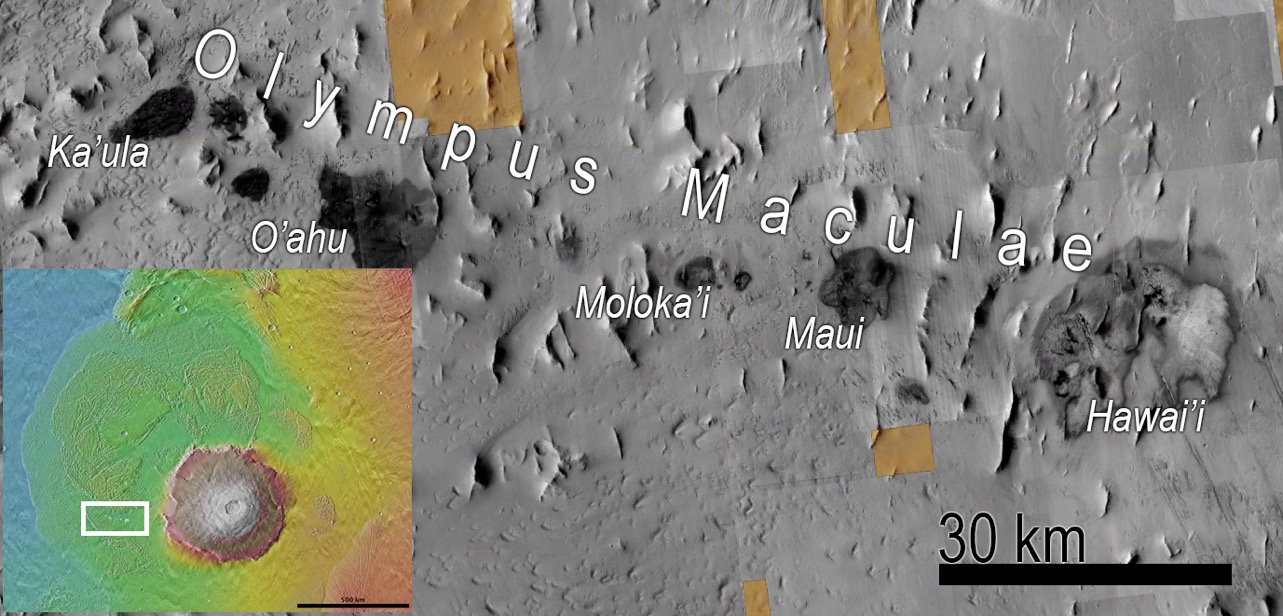Changing Mars

For the full images click here (2019) and here (2020).
While Mars appears to be a dead planet, with no clear evidence of life so far discovered, the planet is hardly inactive. Things are changing there continuously, even if it happens at a slower pace than here on Earth.
To the right are two images, rotated, cropped, and reduced to post here, taken by the high resolution camera of Mars Reconnaissance Orbiter. The first was on January 19, 2019, shortly after the end of the global dust storm that engulfed Mars during that Martian year. The second was taken on February 14, 2020, half a Martian year later. Both show one of a string of dark splotches located on the western flanks of the giant volcano Olympus Mons. Scientists call these splotches maculae, and because of their superficial resemblance to the islands of Hawaii, have given them names matching those islands. This particular patch is dubbed Maui. Below is a map showing all the splotches and their position relative to Olympus Mons, taken from a 2019 presentation [pdf].

I wrote about these splotches in December 2019, describing them as magnets for dust devils. For reasons not yet clearly understood, these dark areas attract dust devils, which act to clear off any dust that might get blown there by large dust storms such as the one in 2018.
The two images above illustrate this quite clearly. Right after the global dust storm the outer edges of the splotch have become very indistinct, the overall splotch is lighter, and there several dust devil tracks visible. Apparently that dust storm had deposited a layer of dust across the entire face of the maculae, lightening it considerably.
A half Martian year later the splotch is dark, its edges clearly defined, and all dust devil tracks are gone.
To confirm my impressions I emailed geologist Kirby Runyon of the Applied Physics Lab in Maryland, who has been studying these splotches for years and had helped answer my questions previously. He added that the dark splotch had actually
…gone back largely to how it was in 2009. I note dust devil tracks are now gone—probably because the whole macula has been stripped of dust and not just in individual dust devil tracks.
In other words, these dark maculae attract so many dust devils that they were able to literally vacuum the entire splotch in less than half a Martian year, removing not only the scattered dust but any evidence of their own tracks.
The mystery here however is that scientists do not detect dust devils in any of the surrounding terrain. Only above these splotches do the devils congregate. Even more baffling, when they reach the splotch’s edge they apparently just fade away.
On Christmas Eve 1968 three Americans became the first humans to visit another world. What they did to celebrate was unexpected and profound, and will be remembered throughout all human history. Genesis: the Story of Apollo 8, Robert Zimmerman's classic history of humanity's first journey to another world, tells that story, and it is now available as both an ebook and an audiobook, both with a foreword by Valerie Anders and a new introduction by Robert Zimmerman.
The print edition can be purchased at Amazon or from any other book seller. If you want an autographed copy the price is $60 for the hardback and $45 for the paperback, plus $8 shipping for each. Go here for purchasing details. The ebook is available everywhere for $5.99 (before discount) at amazon, or direct from my ebook publisher, ebookit. If you buy it from ebookit you don't support the big tech companies and the author gets a bigger cut much sooner.
The audiobook is also available at all these vendors, and is also free with a 30-day trial membership to Audible.
"Not simply about one mission, [Genesis] is also the history of America's quest for the moon... Zimmerman has done a masterful job of tying disparate events together into a solid account of one of America's greatest human triumphs."--San Antonio Express-News

For the full images click here (2019) and here (2020).
While Mars appears to be a dead planet, with no clear evidence of life so far discovered, the planet is hardly inactive. Things are changing there continuously, even if it happens at a slower pace than here on Earth.
To the right are two images, rotated, cropped, and reduced to post here, taken by the high resolution camera of Mars Reconnaissance Orbiter. The first was on January 19, 2019, shortly after the end of the global dust storm that engulfed Mars during that Martian year. The second was taken on February 14, 2020, half a Martian year later. Both show one of a string of dark splotches located on the western flanks of the giant volcano Olympus Mons. Scientists call these splotches maculae, and because of their superficial resemblance to the islands of Hawaii, have given them names matching those islands. This particular patch is dubbed Maui. Below is a map showing all the splotches and their position relative to Olympus Mons, taken from a 2019 presentation [pdf].

I wrote about these splotches in December 2019, describing them as magnets for dust devils. For reasons not yet clearly understood, these dark areas attract dust devils, which act to clear off any dust that might get blown there by large dust storms such as the one in 2018.
The two images above illustrate this quite clearly. Right after the global dust storm the outer edges of the splotch have become very indistinct, the overall splotch is lighter, and there several dust devil tracks visible. Apparently that dust storm had deposited a layer of dust across the entire face of the maculae, lightening it considerably.
A half Martian year later the splotch is dark, its edges clearly defined, and all dust devil tracks are gone.
To confirm my impressions I emailed geologist Kirby Runyon of the Applied Physics Lab in Maryland, who has been studying these splotches for years and had helped answer my questions previously. He added that the dark splotch had actually
…gone back largely to how it was in 2009. I note dust devil tracks are now gone—probably because the whole macula has been stripped of dust and not just in individual dust devil tracks.
In other words, these dark maculae attract so many dust devils that they were able to literally vacuum the entire splotch in less than half a Martian year, removing not only the scattered dust but any evidence of their own tracks.
The mystery here however is that scientists do not detect dust devils in any of the surrounding terrain. Only above these splotches do the devils congregate. Even more baffling, when they reach the splotch’s edge they apparently just fade away.
On Christmas Eve 1968 three Americans became the first humans to visit another world. What they did to celebrate was unexpected and profound, and will be remembered throughout all human history. Genesis: the Story of Apollo 8, Robert Zimmerman's classic history of humanity's first journey to another world, tells that story, and it is now available as both an ebook and an audiobook, both with a foreword by Valerie Anders and a new introduction by Robert Zimmerman.
The print edition can be purchased at Amazon or from any other book seller. If you want an autographed copy the price is $60 for the hardback and $45 for the paperback, plus $8 shipping for each. Go here for purchasing details. The ebook is available everywhere for $5.99 (before discount) at amazon, or direct from my ebook publisher, ebookit. If you buy it from ebookit you don't support the big tech companies and the author gets a bigger cut much sooner.
The audiobook is also available at all these vendors, and is also free with a 30-day trial membership to Audible.
"Not simply about one mission, [Genesis] is also the history of America's quest for the moon... Zimmerman has done a masterful job of tying disparate events together into a solid account of one of America's greatest human triumphs."--San Antonio Express-News


War of the Worlds remember that have been talking about Life on Mars for a long time and marvin and K-9 and Instant Martians(Just add Water)and all that other stuff